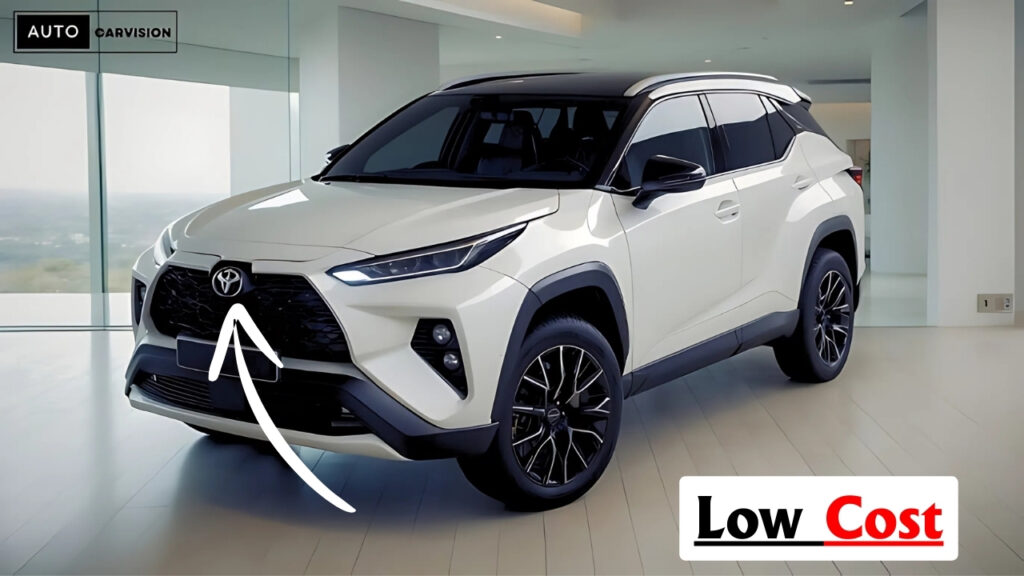Mini Fortuner: The Indian automotive sector is experiencing a revolutionary change, with SUVs solidifying their status as the reigning champions of the road.
Amidst this evolving landscape, Toyota is poised to unveil a groundbreaking vehicle that aims to bring the iconic Fortuner’s essence to a more wallet-friendly price: the Mini Fortuner.
This forthcoming SUV is meticulously crafted to rival popular models such as the Mahindra Scorpio and Thar Roxx, appealing to budget-conscious buyers eager to own a powerful, feature-rich SUV.
The Mini Fortuner signifies Toyota’s pledge to make premium SUV features more accessible while upholding the brand’s long-standing reputation for reliability and performance that has resonated with Indian consumers.
SUVs have surged in popularity, seizing over half of the market share in India and still on the rise.
There’s a growing appetite for four-wheel-drive vehicles that effortlessly blend rugged off-road capabilities with urban driving ease.
This trend presents a golden opportunity for manufacturers to roll out more affordable and versatile SUV choices.
The escalating demand for SUVs is fueled by a range of factors, including enhanced road conditions, increasing disposable incomes, and a shift in consumer preferences toward vehicles that balance functionality with status.
The Mini Fortuner is ideally situated to leverage this market evolution, delivering an appealing mix of practicality, performance, and prestige.
Mini Fortuner: Key Specifications and Expectations
Platform and Design
The Mini Fortuner is likely to adopt the TNGA-C platform, potentially featuring a selection of 2.0-liter four-cylinder engines, some with hybrid options.
In contrast to the full-sized Fortuner, this iteration is anticipated to forgo a body-on-frame setup, opting instead for a flexible platform that accommodates various body styles and powertrains.
This contemporary architecture is expected to deliver improved handling, fuel efficiency, and ride comfort compared to traditional SUV frameworks.
Its design draws on Toyota’s latest aesthetic principles while retaining the muscular stance that appeals to SUV enthusiasts.
Cutting-edge aerodynamics and lightweight materials are set to play vital roles in enhancing performance and efficiency.
Pricing Strategy
The estimated cost for the Mini Fortuner ranges between Rs. 20 – 27 Lakh, making it an enticing choice for those seeking a premium SUV experience without the hefty price tag.
Currently, the launch date is projected for June 15, 2027. This competitive pricing reflects Toyota’s deep understanding of the Indian market’s sensitivity to cost, ensuring the vehicle’s profitability.
To achieve this, the company plans to focus on local production, strategic feature selection, and leveraging economies of scale.
Various trims will be available to meet the diverse preferences and budget limits of potential customers, enhancing market reach.
Emerging Trends in the Budget SUV Segment
1. Safety First
Manufacturers are increasingly prioritizing safety, as many budget SUVs are now equipped with six airbags as standard.
This trend confirms that affordability does not sacrifice passenger safety.
The Mini Fortuner is poised to elevate safety standards in its category, incorporating advanced features like electronic stability control, hill-start assist, and autonomous emergency braking.
These advancements reflect the heightened awareness and demand for safer vehicles within the Indian market, especially among families seeking reliable SUVs.
Toyota’s dedication to safety aligns seamlessly with these evolving consumer expectations.
2. Technology and Connectivity
Today’s budget SUVs are no longer just basic vehicles. They are now outfitted with advanced connected technologies, including:
-
Voice-activated controls
-
Smartphone compatibility
-
In-car Wi-Fi
-
Sophisticated infotainment systems
These enhancements elevate the driving experience, transforming SUVs into much more than mere transportation.
The Mini Fortuner is expected to boast an extensive suite of connectivity features, with over-the-air updates, remote monitoring, and advanced driver assistance systems.
Artificial intelligence and machine learning technologies will likely provide predictive maintenance alerts and tailor-made driving suggestions.
The infotainment system is anticipated to support multiple regional languages, ensuring seamless integration with popular applications and services tailored for the Indian audience.
Such technological advancements symbolize a significant progression toward making premium features accessible to budget-focused buyers while retaining the robust nature expected from SUVs.
3. Powertrain Innovations
The automotive sector is witnessing remarkable advancements in powertrain technology, highlighting a major shift towards sustainability and efficiency. Innovations include:
-
The rapid rise of electric SUVs, showcasing breakthrough battery technology and prolonged range capabilities
-
Next-gen hybrid powertrains that promise up to 40% better fuel efficiency compared to traditional engines
-
Advanced safety technologies, featuring sophisticated automatic emergency braking with pedestrian detection
-
Enhanced lane-keeping assistance using AI for more accurate road alignment
-
Cutting-edge adaptive cruise control with stop-and-go functionality for smooth traffic management
Why the Mini Fortuner Matters
Toyota’s strategy with the Mini Fortuner showcases remarkable market understanding and proactive planning.
The company has recognized that the full-sized Fortuner has built up a stellar reputation for reliability and performance, but its pricing has steadily increased, with top models nearing Rs 60 lakh.
This price surge has created a void in the market that the Mini Fortuner intends to fill by making Toyota’s renowned reliability and engineering accessible at a lower price point.
This initiative reflects a well-thought-out response to changing consumer demands and market realities.
Competitive Landscape
The Mini Fortuner will enter a competitive arena populated by several strong contenders:
-
Mahindra Scorpio N, acclaimed for its sturdy build and impressive off-roading features
-
Mahindra Thar, well-known in the lifestyle SUV category for its distinctive design
-
Kia Sonet, which brings premium features and sleek urban aesthetics to the table
-
Tata Nexon, recognized for its superb safety ratings and excellent value for money
The SUV landscape in 2025 exhibits notable trends shaping consumer choices:
-
Broad customization possibilities that allow buyers to tailor their vehicles to their tastes
-
An increasing emphasis on personal style, with manufacturers offering unique design elements
-
The incorporation of advanced tech features, such as AI-integrated systems and connected car functionalities
-
Growing interest in eco-friendly options, including hybrids and electric vehicles
Potential Market Impact of the Mini Fortuner
Toyota’s launch of the Mini Fortuner signifies more than just a new vehicle; it marks a pivotal change in making premium SUV experiences more attainable.
This strategic decision could potentially alter the dynamics of the entire segment. The vehicle forms part of a broader global strategy, with Toyota likely set to develop market-specific versions tailored to meet unique regional demands, especially in developing nations.
This approach illustrates Toyota’s commitment to expanding its footprint in global markets while remaining sensitive to local preferences and economic climates.
Conclusion: A New Era of Affordable SUVs
The Mini Fortuner embodies a significant leap forward in the automotive sector. It marks a major step in making advanced, reliable, and feature-rich vehicles available to a wider audience.
This vehicle symbolizes the industry’s shift toward democratizing premium features that were once exclusive to higher-end models.
As market trends continue to evolve, Toyota’s forward-thinking approach of bringing premium amenities to budget-friendly segments is set to reshape industry expectations.
For value-driven consumers who have long aspired to own a Fortuner but faced financial limitations, the Mini Fortuner emerges as an attractive alternative.
It successfully melds Toyota’s esteemed reliability with state-of-the-art technology and competitive pricing, creating an enticing offering that promises remarkable value without skimping on essential features or build quality.
Looking Ahead
As more details about the Mini Fortuner gradually come to light, industry experts and market analysts unanimously agree on one critical aspect: this vehicle is poised to make a significant mark on the Indian automotive landscape.
The launch of the Mini Fortuner may incite a broader industry movement towards more accessible premium offerings, potentially motivating competitors to create similar products.
This competitive environment could lead to enhanced choices and improved value propositions for consumers across the segment.
Prospective buyers should keep an eye on forthcoming announcements from Toyota, as additional features, specifications, and pricing information are expected soon.
The anticipation surrounding this launch highlights the market’s excitement for premium vehicles that are both affordable and high-quality.


